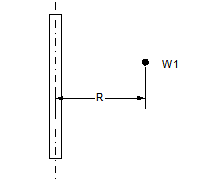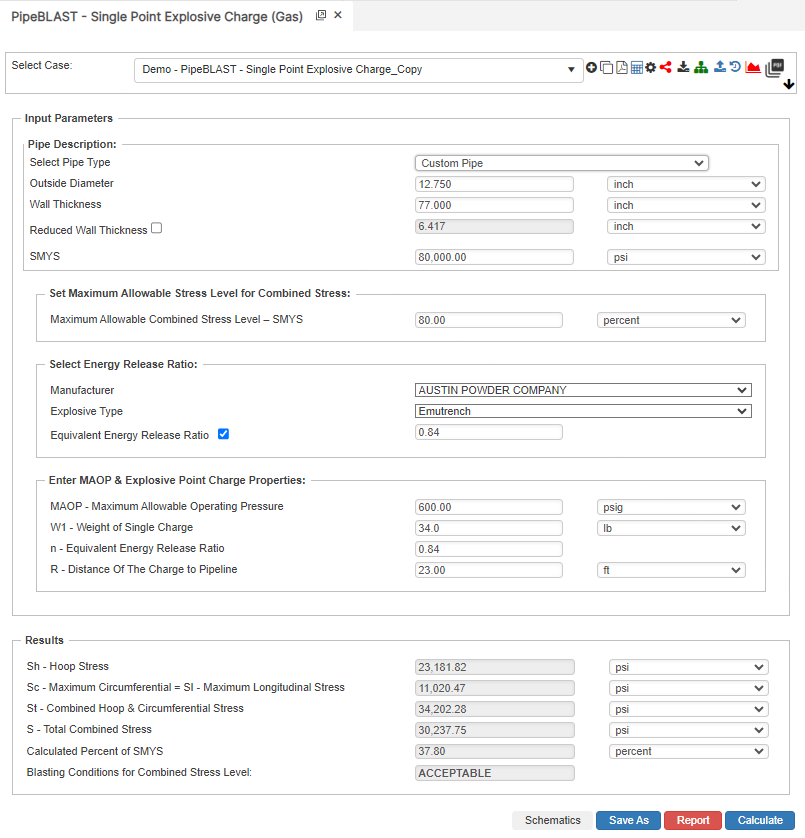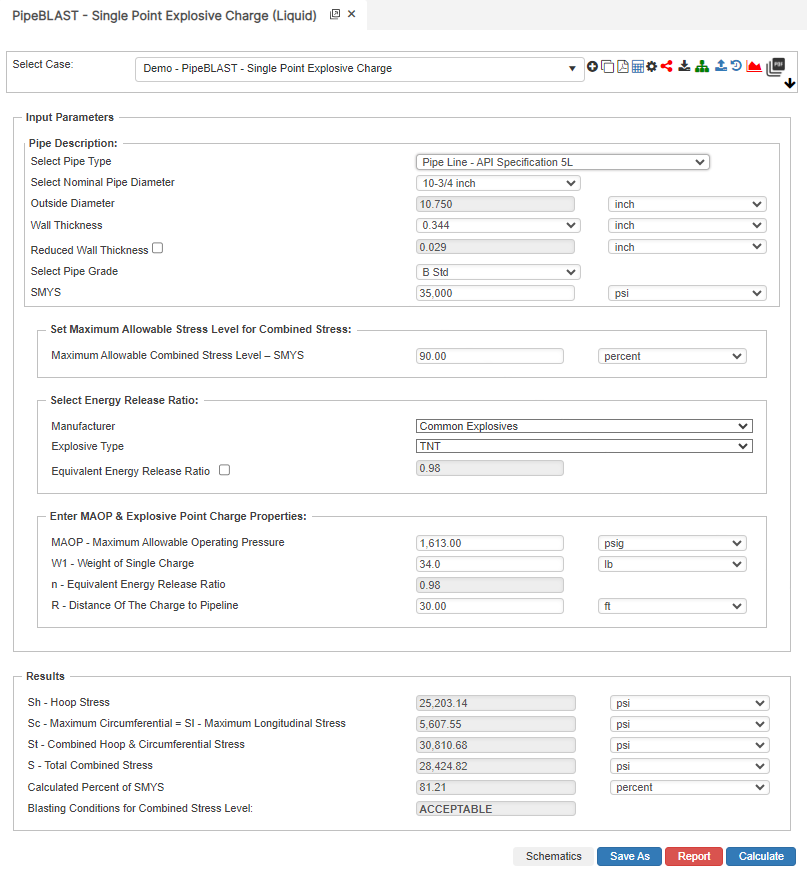Introduction
A single point charge is used in estimating the stress magnitudes to the pipe. :A=R
A=R
The minimum distance from the pipeline to the nearest explosive charge must be greater than two times the outside pipe diameter. A<\frac{2D}{12}\~\S_h=\frac{PD}{2t}
A<\frac{2D}{12}\\~
\\S_h=\frac{PD}{2t}Where:
R − Distance from the Charge to the Pipeline(ft)
P − MAOP−Maximum Allowable Operating Pressure(psi)
P − Pipeline Outside Diameter(in)
t − Pipe Wall Thickness(in)
Sℎ − Hoop Stress(psi)
S_c = 4.44E \left( \frac{nW}{\sqrt{(Et)(R^{2.5})}} \right)^{0.77} \~\ S_t=S_h+S_c\~\ S=\sqrt{S_t^2-(S_tS_c)+S_c^2}
S_c = 4.44E \left( \frac{nW}{\sqrt{(Et)}(R^{2.5})} \right)^{0.77} \\~\\ S_t=S_h+S_c\\~\\ S=\sqrt{S_t^2-(S_tS_c)+S_c^2}Where:
S𝑐 − Maximum Circumferential = S𝑙 − Maximum Longitudinal Stress(psi)
n − Equivalent Energy Release Ratio
W − Weight of Single Charge(lbs)
E − Modulus of Elasticity
t − Pipe Wall Thickness(in)
S𝑡 − Combined Hoop and Circumferential Stress(psi)
Calculated\,\%\,SMYS=\frac{S}{SMYS}100
Calculated\,\%\,SMYS=\frac{S}{SMYS}100Blasting Conditions for combined Stress Level
𝐶𝑎𝑙𝑆𝑀𝑌𝑆 >%𝑆𝑀𝑌𝑆 − NOT ACCEPTABLE/𝐶𝑎𝑙𝑆𝑀𝑌𝑆 <%𝑆𝑀𝑌𝑆 − ACCEPTABLE
Schematics

W1 – Weight of Explosive Charge
R – Perpendicular Distance of the Explosive Charge to Pipeline
Case Guide
Part 1: Create Case
- Select the Single Point Explosive Charge application from the Pipe Blast module.
- To create a new case, click the “Add Case” button
- Enter Case Name, Location, Date and any necessary notes.
- Fill out all required parameters.
- Make sure the values you are inputting are in the correct units.
- Click the CALCULATE button to overview results.
Input Parameters
- Pipe Outside Diameter
- Pipe Wall Thickness
- Specified Minimum Yield Strength
- Maximum Allowable Combined Stress Level – SMYS
- Manufacturer
- Explosive Type
- Equivalent energy release ratio
- MAOP – Maximum Allowable Operating Pressure
- W1 – Weight of Single Charge
- n – Equivalent Energy Release Ratio
- R – Distance of the Charge to Pipeline


Part 2: Outputs/Report
- If you need to modify an input parameter, click the CALCULATE button after the change.
- To SAVE, fill out all required case details then click the SAVE button.
- To rename an existing file, click the SAVE As button. Provide all case info then click SAVE.
- To generate a REPORT, click the REPORT button.
- The user may export the Case/Report by clicking the Export to Excel icon.
- To delete a case, click the DELETE icon near the top of the widget.
Results
- Sh – Hoop Stress
- Sc-Maximum Circumferential = Sl-Maximum Longitudinal Stress
- St – Combined Hoop && Circumferential Stress
- S – Total Combined Stress
- Calculated Percent of SMYS
- Blasting Conditions for Combined Stress Level:




References
- SWRI – Pipeline Response to Buried Explosive Detonations – Volume I
- SWRI – Pipeline Response to Buried Explosive Detonations – Volume II
- PRCI – Pipeline Response to Blasting in Rock
FAQ
-
What Are The Blasting Calculations Used Around Pipelines?
Many oil, and gas pipeline companies have minimum requirements regarding blasting around their pipeline facilities. A common blasting requirement is blasting within 200 feet or using vibratory equipment within 25 feet of a pipeline. Unfortunately, blasting take places at very close proximities due to construction and other real activities such sewer, water, cable, etc. that cause stresses to these pipelines. Check Out
-
Estimating Equivalent Release Ratio?
Most chemical explosives have close to the same energy release per unit weight (We). If the explosive being used in a blasting situation is not known, the prediction equations can be used substituting a “typical” value for (We). Check Out
